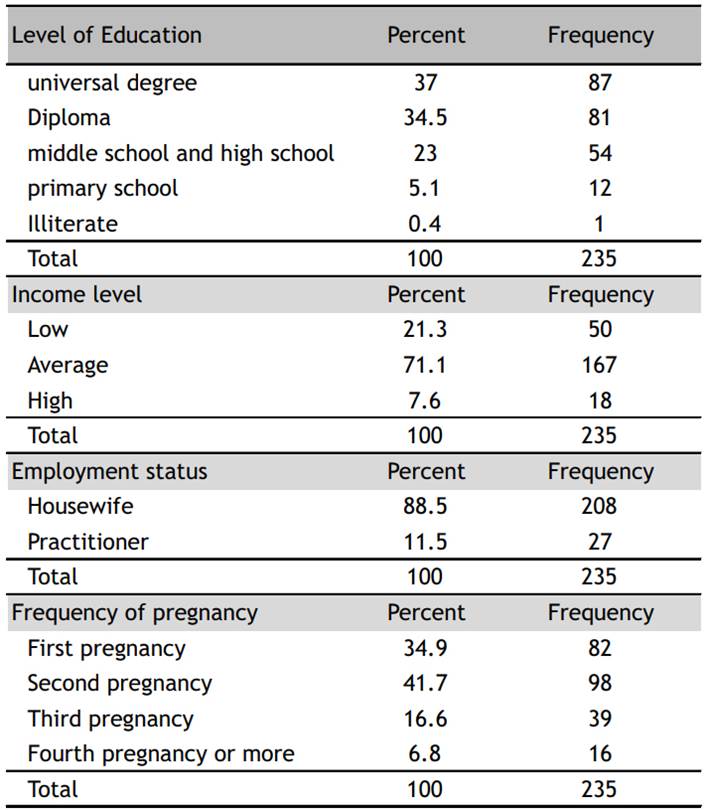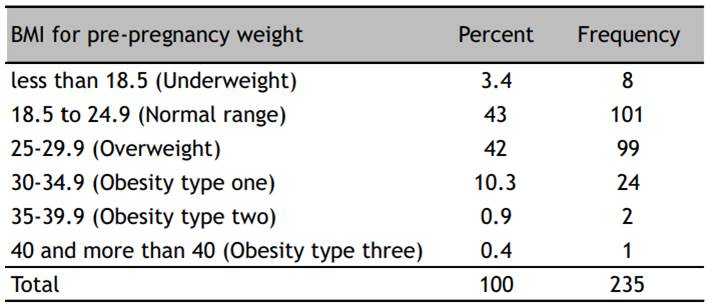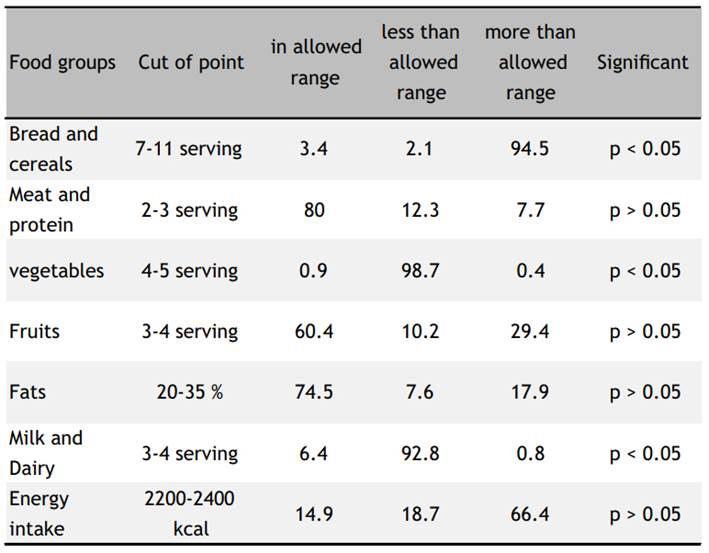INTRODUCTION
Pregnancy is counted as one of the most important stages in women's life which causes several physiological and mental changes in women1. In pregnancy period, fetus grows fast and it needs to different kinds of nutrients to proliferate it cells and these nutrients should be prepared by suitable maternal nutrition2. Nutrition in pregnancy period has great importance because in addition to mother and embryo's health, affects the result of pregnancy3. The researches of World Health Organization Have shown that around 600,000 of pregnant women are died because of illnesses in pregnancy period and approximately 50% of all pregnant women all around the world are diagnosed with anemia, lack of calcium and vitamin A4. Therefore, suitable maternal nutrition in pregnancy, in addition to the complete growing up the embryo, prepares the necessary resources for lactation in the first six months after birth5.
Some mothers avoid using foodstuffs even in enough sufficiency because of fearing of getting fat, while others, use foodstuffs more than their needs in pregnancy period which causes appearing high blood pressure, obesity, pregnancy diabetes, long delivery, preeclampsia and increasing prevalence of caesarean section6-8. Receiving less amounts of energy and protein in pregnancy is related to the low birth weight and preeclampsia or (pregnancy poisoning), while pregnancy diabetes is related to extra receiving of energy and oil and also receiving less amount of vitamins and minerals9. Unsuitable nutrition of mother in pregnancy period causes to increase the limitation of embryo growth to nine fold10. Maternal weighing during pregnancy, causes the baby getting bigger inside the uterus if it is more than normal, and if it is less than normal, it leads to preterm delivery, low birth weight for the gestational age and no breast feeding11.
Due to the importance of nutrition in pregnancy, having a healthy and suitable diet can guarantee a secure pregnancy period and delivery; For this reason, evaluating the nutritional status of pregnant women and discovering nutritional problems during pregnancy and dealing with them is one of the priorities that the World Health Organization has given priority to pregnancy12. The first stage of nutritional care is a wide and complete assessment which is done by nutritionists and it is called the nutritional status assessment. This assessment provides information about clinical, nutritional, pharmacological, and anthropometric and biochemical characteristics of individuals that are helpful in determining nutritional support and medical nutrition therapy13.
Food patterns form based on different factors such as culture, race, and many environmental factors such as food availability, food purchasing power and advertising14. Usually nutritional pattern in pregnancy period which prepare needs in this period consist of consuming milk, chicken and meat, fish and sunflower, eggs and legumes15. In the special food pyramid in pregnancy period, 9 units of bread and cereals, 5 units of fruits and vegetables, 2 units of meat and legumes, 3 units of dairy and 2 units of food groups are can considered6.
So finally we can say that nutritional assessment helps to identify suitable foodstuff to use in pregnancy period, the suitable amount of foodstuff using in pregnancy period and even the number of using that food during day. Also gathered information about nutritional assessment can be used in nutritional counseling for pregnant women16. Due to the direct relationship between the nutritional pattern of pregnant women and their health and their fetus and also considering that the nutritional pattern of each region is derived from the culture of the same region and may differ with other areas, this study was done to determine the nutritional pattern in pregnant women who referred to Yasuj health centers.
METHODS
This study is a cross-sectional descriptive study in which the Cochran formula was used to determine the sample size. Samples were selected from all pregnant women who were in the second trimester of pregnancy (N=600) and had no specific disease or diet. The samples were selected because the relationship between maternal weight gain during pregnancy and fetal growth was higher in the second trimester of pregnancy than in the first and third trimesters of pregnancy and showed maternal nutritional status clearer10; Therefore, by simple random sampling technique, 235 pregnant women who were in the second trimester of pregnancy or (14 to 28 weeks of pregnancy) were randomly selected from all pregnant women in each health center. Questioners collected the information by personal interviewing of 235 pregnant women referring to Yasuj health centers consist of (Shahid Sadooghi, Shahid Shafii, Shahid Dastgheib, Shahid Ashrafi Esfahani).
In this study, required information was collected by two sectional questionnaire consist of 48 items Food Frequency Questionnaire (FFQ) which its validity and stability is confirm in studies17,18 and the demographic characteristics such as (age, level of education, the level of income, employment status, number of pregnancies and BMI).
FFQ contains some questions about the usage of different food groups such as bread and cereals, vegetables, fruit, milk and dairy, meat and high-calorie foods such as simple sugars and lipids that if one foodstuff is used, the amount of using it during the previous day, week, month and/or year is expressed. The maternal weight before pregnancy and mother's BMI was set down by using their health records and if the measurement of weight and height was needed, scale and meter were used. The number of recommended allowed unit in pregnancy period is for bread and cereal food group (7-11 units), vegetables (4- 5 units), fruits (3-4 units), milk and dairy (3-4 units), meat and protein (2-3 units), lipids (20-35 %) and energy intake (2200-2400 kilocalories).
Analysis of FFQ by NUT4 software and analysis of data by SPSS software and statistic descriptive tests such as (affluence, average and standard deviation) were done. Also statistic T-test was use to compare the number of allowed unit of food groups for pregnant women in the second trimester of pregnancy with the average of the number of using units in food groups by the populations under study.
RESULTS
Results showed that the age range in 235 pregnant women who participated in this study has been between 19 to 42 years with the average of 28.3 and standard deviation of 6.15 (Table 01). Based on the level of education, 37% of participants had universal degree, 34.5% of them had diploma, 23% of them had middle school and high school degree, 5.1% of them had elementary school degree and 0.4% of them were illiterate, based on the level of income 21.3% of participants had low income, 71.7% of them had average income and 7.7% of participants had high income. 88.5% of participants were housewife and just 11.5% of them were practitioner, 34.9% of participants were passing their first pregnancy, 41.7% of them were passing the second pregnancy, 16.6% of them were passing their third pregnancy and 6.8% of them were passing their fourth pregnancy or more than their fourth pregnancy (Table 02).
The pre-pregnancy weight of participants was in the range of 40 to 98 kg with the average and standard deviation of 66.63 and 10.83 respectively and their current weight was in the range of 47 to 106 kg with the average and standard deviation of 75.06 and 11.25 respectively (Table 01). The results of the BMI index of pregnant women for pre-pregnancy weight indicated that 3.4% of participants had BMI less than 18.5, less than half of participants (43%) had normal BMI (18.5 to 24.9), 42% of participants had BMI (25 to 29.9), 10.3% of participants had BMI (30 to 34.9), 0.9% of participants had BMI (35 to 39.9) and 0.4% of them had BMI 40 and more than 40 (Table 03).
Table 01 The average and standard deviation of variables of Age, Pre-pregnancy weight and current weight.

Table 02 demographic characteristics of participants included: level of education, income level, employment status, number of pregnancies.

In the study of nutritional intake of pregnant women participating in this study, the results about the usage of bread and cereals food group showed that only 3.4% of participants were using this food group in allowed range. The average number of using units from this food group by population under study was 20 units and the results of T-test showed a significant difference (P < 0.05). About meat and protein food group, 80% of participants were using of this food group in allowed range. The average number of using units of this food group by the population under study was 3 units that the results of T-test didn't show any significant difference (P > 0.05) (Table 04).
The results about vegetables food group showed that 98.7% of participants were using less than allowed range of this food group, 0.9% of participants were using of this food group in allowed range and 0.4% of participants were using more than allowed range of this food group. The average of using units of this food group was 1 unit in people under study that the results of T- test showed significant difference for that (P < 0.05). About the using of fruits group, 10.2% of participants were using less than allowed range of this food group, 60.4% of participants were using in allowed range and 29.4% of participants were using more than allowed range. The average number of using units of this food group was 3 units in people under study that the results of T-test didn't show any significant difference (P > 0.05) (Table 04).
About using fats and oils group, 7.6% of participants were using less than allowed range of this food group, 74.5% of participants were using in allowed range and 17.9% of participants were using more than allowed range of this food group. The average number of using units of this macronutrient in people under study was 28% that the results of T-test didn't show any significant difference (P > 0.05). About milk and dairy food group, the results of this study showed that 92.8% of participants were using less than allowed range of this food group. The average number of using units of this food group in people under study was 1.5 units that the results of T-test showed a significant difference (P < 0.05) (Table 04).
About the amount of energy intake of diet, results showed that energy intake in 18.7% of participants were less than allowed range, in 14.9% of participants were in allowed range and in 66.4% of participants were more than allowed range. The average amount of energy intake was 2450 kilocalorie in people under study that the results of T-test didn't show any significant difference (P > 0.05) (Table 04).
DISCUSSION
The goal of this descriptive cross-sectional study was the assessment of nutritional pattern in pregnant women that the results showed that the majority of pregnant women (94.5%), were using bread and cereals food group more than allowed range but the results of Abedini et al.'s study on the nutritional status of pregnant women showed that the amount of using This food group in pregnant women who participated in their study was less than allowed range and they were different from our results6 which may be the reason of this difference is the difference in geographical location and also the relish of these two population group.
About the usage of meat and protein group, the majority of pregnant women (80%), were using the meat and protein group in allowed range but the results of Farahaninia et al.'s study about nutritional pattern of pregnant women showed that using of meat and protein food group in pregnant women who participated in their study was less than allowed range19. Considering that the majority of families under study about the level of income were in average level, we can say that they didn't have any problem about providing meat and protein food group and this cause the usage of enough amounts of this food group by the majority of people under study.
The results of this study about the usage of vegetables group showed that most of pregnant women (98.7%) were using this food group less than allowed range and just 0.9% of pregnant women were using this food group in allowed range. The results of wen et al.'s study about nutritional habits during pregnancy showed that only very low number of pregnant women (7%) were using this food group in allowed range, but the results of Abedini et al.'s study was different from our study and it showed that the amount of using vegetables group, especially in the second trimester of pregnancy by the majority of pregnant women were more than allowed range20,6. unfamiliarity with benefits and nutrients in vegetables group and also lack of nutritional literacy about this food group can be one of the effective factors on inadequate using of vegetables food group in allowed range.
In this study, the rate of consumption of 60.4% of pregnant women from the fruits food group was at allowed range, while in trout et al.'s study the majority of pregnant women (more than 74%) in both intervention and comparison groups, were using fruits group at allowed range but the results of takimoto et al.'s study related to nutritional status of Japanese pregnant women showed that using of fruits food group by pregnant women was more than allowed rang compare to control group21,22. One of the reasons of using allowed amounts of fruits food group can easy availability to this food group noticing the geographical situation and special weather condition in this area.
The majority of participants in current study (74.5%), were using fats and oils group at allowed range, but the results of Yang et al.'s study about nutritional intake of pregnant women in the northwest of China showed that the usage of fats and oils group in pregnant women were more than allowed range. The results of Myles et al.'s study about nutrition in black pregnant women showed that less than half of pregnant women (43.8%) were using the allowed amount of fats and 21.1% of them were using this food group more than allowed amount23,24. Nutritional habits can be effective in the amount of fats and oils group using because some populations desire to use barbecued foods and others like eating boiled or fried foods and this can be one of the effective factors about using fats and oils group.
The results of current study about using milk and dairy food group showed that using this food group in majority of pregnant women (92.8%) were less than allowed range and the results of this study were similar to the results of George et al.'s study about the nutritional choices of pregnant women25. Having allergies to lactose and the inability to tolerate lactose in the milk and dairy food group could be the reason for the reduction in consumption of this food group. On the other hand, race and geographical location also is one proved issue in tolerating the available lactose in milk and dairy food group which can affect the consumption of this food group among different populations.
The results of this study showed that the majority of pregnant women (66.4%) received more energy than allowed amount but the results of Naem et al.'s study about the zinc status and dietary intake of pregnant women showed that pregnant women participating in their study received less energy from their diet than allowed range so that, their total energy intake was only about 50% of total allowed amount. The results of Delvarianzadeh et al.'s study was also different than the results of our study and showed that average amount of energy intake by pregnant women in their study was less than allowed range26,4. The results of Abedini et al.'s study showed that only half of pregnant women (50%) had received energy from their diet in allowed range27. It seems that the difference in the amount of bread and cereals food group using which have more carbohydrate than other food groups, can be effective in the amount of receiving energy and its difference in different populations.
The results of the present study suggested that pregnant women participating in this study were in bad situation considering the amount of energy intake and macronutrients intake, because they consumed the majority of food groups more or less than allowed range. Because of this, it is needed to give enough information about food groups and the needed amount of them in pregnancy period to all the pregnant women who refer to health centers, because although the majority of pregnant women participating in this study are literate, but this literacy doesn't contain of nutritional literacy and it double the necessity of nutritional education to pregnant women with different level of education and income.
















